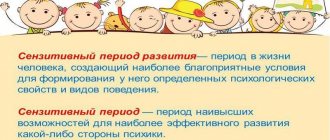4-6 years is a special period in the life of a little person. Speech improves, helplessness goes away, the baby becomes more mature and independent. He makes his first friends, in games with whom his imagination flows like a fountain.
Restlessness is replaced by perseverance and the ability to concentrate develops. The time has come for the first classes to prepare for school. But, along with the independence that makes adults so happy, at this age many parents begin to sound the alarm due to changes in the character of their child.
Physical features of development
In middle preschool age, the child’s physical capabilities increase significantly: coordination improves, movements become more and more confident. At the same time, the constant need to move remains. Motor skills are actively developing; in general, the average preschooler becomes more dexterous and faster than younger ones. It should be noted that the age characteristics of children 4–5 years old are such that physical activity needs to be dosed so that it is not excessive. This is due to the fact that muscles during this period grow, although quickly, but unevenly, so the child gets tired quickly. Therefore, babies need to be given time to rest.
As for the pace of physical development, from 4 to 6 years they do not change significantly. On average, a child grows 5–7 cm per year and gains 1.5–2 kg of weight. All organs and systems of the child’s body grow and develop.
Mental development of a child
At the age of 4–5 years, various mental processes quickly develop: memory, attention, perception and others. An important feature is that they become more conscious and voluntary: volitional qualities develop, which will definitely be useful in the future.
The type of thinking characteristic of a child now is visual-figurative. This means that most of the children’s actions are of a practical, experimental nature. Visibility is very important to them. However, as they grow older, thinking becomes generalized and by older preschool age it gradually turns into verbal-logical thinking. The volume of memory increases significantly: he is already able to remember a short poem or an instruction from an adult. Voluntariness and stability of attention increase: preschoolers can concentrate on any type of activity for a short time (15–20 minutes).
Taking into account the above-mentioned age characteristics of children 4–5 years old, preschool teachers can create conditions for productive work and harmonious development of the child.
Development of a child's personality by age 5
In accordance with the theory of bodynamics, on which body-oriented therapy is based, from 3 to 6 years of age, a person’s structure of love and sexuality is formed. Already at 4 years old, children know exactly what gender they are (boy or girl). They are interested in sexual differences, fall in love with parents of the opposite sex (Oedipus complex according to Z. Freud), and report a desire to replace mom or dad. In response to such statements, parents should say without unnecessary emotions that now their son cannot replace his dad, but in the future he will meet and fall in love with someone his own age.
To provide children with the necessary information in an accessible way and without unnecessary details, you can use special children's literature.
You should not focus the child’s attention on this topic; you should simply make a brief explanation and switch the child’s attention to another activity or game.
At the age of 4, the development and maturation of the emotional sphere begins: your child’s feelings become deeper and more stable. The joy of direct communication turns into a more complex feeling of sympathy and affection. Thus, at this age, moral feelings are formed - sensitivity, kindness, a sense of friendship, and the rudiments of a sense of duty and responsibility appear. Never ignore emotions or prohibit children from expressing them. When commenting on your child’s experiences, teach him to express negative emotions in a civilized manner. Share your feelings with your child, discuss conflict situations from life and children's literature.
To develop your child’s thinking, speech and emotional world, regularly read fiction to your child. The same poems and fairy tales can be read repeatedly. Children at this age really love repeated listening, and at the end, be sure to discuss the characters and their adventures: what particularly interested you and what didn’t you like? Offer to make a drawing for the work. Watching cartoons with your child is very useful. Then ask your child to name the main characters and briefly retell the plot. In this case, it is necessary to pay attention to the character of the characters (evil, kind, cheerful, sad, joyful, etc.). Later, you can play out stories from a book or cartoon with toys with a change of roles.
During the period of 4-5 years, a structure of opinions is formed. The child begins to express his conclusions. They, of course, can be incorrect and erroneous. In the fifth year of life, a child is able to think about topics not related to immediate activity and sometimes come to the wrong conclusions. But adults should show interest in the child’s first intellectual quest and gently guide him in the right direction. It is advisable to welcome such aspirations of the child in every possible way.
Be tactful and do not make fun of the child. You can suggest finding the correct information on this issue together on the Internet or in an encyclopedia. It’s even better to clearly demonstrate the experience so that the child himself comes to the correct judgment. From this age, the child’s intellect is able to accumulate ideas about the world around him, and visual-figurative thinking is formed. With this knowledge, the child acquires a certain attitude towards objects (fear of predators, love for pets, etc.) For the harmonious development of the child, it is necessary not only to give him new knowledge in the form of play, but also to respect the child’s own mental searches and their results . If kids often hear their parents say: “They’re still young, shut your mouth!” etc., then in adolescence such children can indulge in meaningless polemics and disputes. There is a possibility that there will be alienation from parents, withdrawal into the company of peers or computer games. It is possible that in the future such a person will be afraid to express his opinion. And such people are very convenient for everyone to “ride”...
By the age of 4, a creative attitude towards the world is formed. That is, in this period of life there is an intensive development of the child’s cognitive sphere. The child acquires the ability and opportunity to transform objects in the surrounding world. Computer games at this age are not yet recommended, and games for the development of fine motor skills (sorters, puzzles, Legos, various construction sets) are especially useful. Children are attracted to sports and outdoor games, games with large toys (dolls, cars), which develop coordination well.
Children really like role-playing games: family, construction site, store, hospital, kindergarten, concert, etc., which contribute to the development of the child’s personality. These games actively develop the imagination; they encourage the child to use substitute objects. A spoon can be a sword, a shovel, a car, etc. But in order for a child’s role-playing game to become a truly leading activity, adults need to be actively involved in play activities. Take on different roles and enrich the storyline, awakening the imagination of a child of the fifth year of life.
Children are happy to engage in creative activities: drawing with pencils and paints, and learn with interest sculpting from soft plasticine and appliqué.
The child begins to become aware of himself in this world and begins to more sensitively perceive the attitude of others towards him. During the period of 4-5 years, a child develops such an important new personality formation as self-esteem. The process of forming self-esteem depends on active communication with adults, on interaction with the world around him. The child copies the behavior of parents and older siblings, especially behavior that receives positive feedback from others.
Every child by nature wants to be good in order to deserve praise and appreciation. Therefore, it is important for adults to encourage such aspirations. If a child does well, he must be supported with praise, and be sure to indicate why he is being praised. How to introduce prohibitions into a child’s life is described in detail in this article.
However, it is very difficult for a child of five years of age to evaluate himself critically. He may doubt his abilities, but it is still difficult for him to admit his guilt. A preschool child of the fifth year of life develops conscious personal desires and interests, preferences in clothing, which at this age stage must be taken into account. During this period of life, children actively strive for independence, but mistakes sometimes greatly upset them. And if there are a lot of failures, and the child does not receive moral support from adults, but hears ridicule and reproach, he may develop a feeling of self-doubt.
Role of the game
Play activity still remains the main activity for the baby, but it becomes significantly more complicated compared to an early age. The number of children participating in communication is increasing. Thematic role-playing games appear. The age characteristics of children 4–5 years old are such that they are more inclined to communicate with peers of the same sex. Girls prefer family and everyday topics (mothers and daughters, shopping). Boys prefer to play sailors, military men, and knights. At this stage, children begin to organize their first competitions and strive to succeed.
Communication
How do kids communicate? Different than with adults. The first thing that catches your eye is increased emotionality. They can rarely speak normally. They scream, laugh, squeal, rush around, and at the same time choke with delight. Adults often do not understand such reactions.
That is why the majority of children, especially of this age period, behave more relaxed and freer with their peers. In communication between peers, one can observe more feelings, expressive and facial manifestations than when addressing adults.
Show your child how to initiate communication
When communicating with adults, children try to adhere to at least relative norms and decency. In communicating with each other, for example, they often use completely unexpected sounds, fables, and words.
Sometimes children are embarrassed to communicate both with peers and with adults. To prevent this phenomenon from developing into a psychological problem, adults need to neutralize this phenomenon and look for a way out of this situation.
For example, help a child and introduce him to the social circle of other children with the words: “Hi guys! Our names are Katya and Masha, let's play together.” In the future, the child will learn to get acquainted and communicate on his own.
Creative skills
Middle preschoolers enjoy mastering various types of creative activities. The child likes to do plot modeling and appliqué. One of the main ones is visual activity. The age characteristics of children 4–5 years old according to the Federal State Educational Standard suggest that at this stage the preschooler has already mastered fine motor skills, which allows him to draw in detail and pay more attention to details. Drawing becomes one of the means of creative self-expression.
The average preschooler can compose a short fairy tale or song, understands what rhymes are and uses them. Vivid imagination and rich imagination allow you to create entire universes in your head or on a blank sheet of paper, where a child can choose any role for himself.
Speech development
During the middle preschool period, active development of speech abilities occurs. Sound pronunciation improves significantly, vocabulary actively grows, reaching approximately two thousand words or more. Speech age characteristics of children 4–5 years old allow them to more clearly express their thoughts and fully communicate with peers.
The child is already able to characterize this or that object, describe his emotions, retell a short literary text, and answer an adult’s questions. At this stage of development, children master the grammatical structure of the language: they understand and correctly use prepositions, learn to construct complex sentences, and so on. Coherent speech develops.
Communication with peers and adults
In middle preschool age, contacts with peers become of paramount importance. If previously a child had enough toys and communication with his parents, now he needs interaction with other children. There is an increased need for recognition and respect from peers. Communication, as a rule, is closely related to other types of activities (games, joint work). The first friends appear with whom the child communicates most willingly.
Competition and the first leaders begin to emerge in the group of children. Communication with peers is, as a rule, situational in nature. Interaction with adults, on the contrary, goes beyond the specific situation and becomes more abstract. The child regards his parents as an inexhaustible and authoritative source of new information, and therefore asks them many different questions. It is during this period that preschoolers experience a special need for encouragement and are offended by comments and if their efforts go unnoticed. Sometimes adult family members do not notice these age-related characteristics of children 4–5 years old. A memo for parents, compiled by teachers and psychologists of a preschool institution, will help to correctly and fruitfully build communication with the child.
Difficulties in raising a child aged 4, 5 and 6 years
A feature of the psychology of this age group is the crisis of social relations. But, taking into account the above, the formation of a model of relationships with society through “bad” behavior is the norm for 4-6 years old.
In this way, the preschooler builds the boundaries of his own territory and tries to be more independent and free.
Parents need to accept their child for who he is without unnecessary nervousness, give him the opportunity to do his own actions and take responsibility for them, establish joint rules with the child and not allow him to go beyond what is permitted.
Emotional Features
At this age, significant development of the sphere of emotions occurs. This is the time of first sympathies and affections, deeper and more meaningful feelings. A child can understand the mental state of an adult close to him and learns to empathize.
Children are very emotional about both praise and comments; they become very sensitive and vulnerable. By the age of 5, a child begins to be interested in issues of sex and his or her gender identity.
As already mentioned, one of the distinctive features of this age is vivid fantasy and imagination. It must be borne in mind that this can give rise to a variety of fears. A child may be afraid of a fairy tale character or imaginary monsters. Parents do not need to worry too much: this is not a problem, but only the age characteristics of children 4–5 years old.
Psychology knows many ways to combat such fears, but it is important to remember that these are just temporary difficulties that will go away over time if parents do not focus on them or use them against the child for educational purposes.
Tips on how to properly raise a 4-year-old child
The main tasks of raising a child in the 4th year of life are:
- encouraging his desire to learn as much as possible;
- developing skills for proper communication with others;
- introduction to cultural life;
- developing skills to manage one’s own emotions;
- physical development.
The competent development of a four-year-old child forms the basis for raising a child of 5-6 years old.
Features of education
The peculiarities of raising a 4- and 5-year-old child, first of all, lie in the ability of parents to work proactively. Correcting a child’s incorrect behavior takes much longer.
Modern child psychology suggests paying attention to the following educational aspects :
- Whims . The main indicator that the little man has noticed a weakness in the educational process. Correcting this behavior consists of completely ignoring or switching the child’s attention to another object.
- Games . Full development in this period is simply impossible without them. But it is adults who must control the quality of such products, giving preference to the developing segment.
- Information . Computers, TV and other means of obtaining information must certainly be censored by parents.
- Examples to follow . And finally, about the main thing. Most often, parents need to start correcting children's behavior with themselves. And only by correcting your own shortcomings can you demand correction from your own child.
Moral education of a child
Psychology for this age group notes that for the moral development of children, 4 and 5 years old are the most fertile time. Right now is the easiest time to strengthen in a little person the concepts of good and evil, honesty and generosity, truth, lies, etc.
But, convincing him of the correctness of such norms of behavior, in no case should you be annoying or boring. Use examples from life and do not forget about the main motivator - encouraging positive qualities.
Proper upbringing advice from a psychologist
Age needs directly determine the psychology of proper education of preschool children.
Advice for parents from professionals in the field:
- Remember that the full development of the baby is possible only in an atmosphere of absolute love and security.
- The maximum educational effect from the child’s activities is achieved only in case of tangible success.
- Frequent refusals to answer the questions of a little why in childhood form the child’s reluctance to share secrets with his parents in adulthood.
- To protect yourself from active resistance on the part of the preschooler, the educational process must be open.
Education for children 4–5 years old
When training, employees of preschool institutions take into account the psychological and age characteristics of children 4–5 years old. According to the program “From birth to school”, currently used, the emphasis is on the formation and comprehensive development of the individual.
At the same time, thematic classes are held with children, which explain the rules of behavior in a team, at home and in public places, the basics of safety, speech development, hygiene skills are improved, and so on. At the same time, the educational process is based on the game. Thus, teachers introduce the child to new concepts and rules through an activity that is accessible and attractive to him, taking into account the age characteristics of children 4–5 years old. According to traffic rules, for example, game classes can be held, where traffic rules are given in poetic form, easy to understand and remember. Also at this age it is necessary to expand the child’s horizons and his knowledge about the world around him.
Important tasks of raising a child
- develop communication skills;
- instill norms and rules of behavior in society;
- promote the development of self-control in behavior;
- develop mental abilities and thirst for knowledge;
- notice in time the child’s interests and inclinations for one or another activity in order to help him develop his talent;
- find a middle ground between playing and time for learning activities;
- Raising a 4-year-old child should still be filled with your care and love for him, because he spends a lot of time in kindergarten and clearly does not get enough attention.
Upbringing
Speaking about raising children of this age, we must remember that at this stage the character changes significantly. The crisis of three years passes safely, and the child becomes much more obedient and flexible than before. It is at this time that children need full communication with their parents. Strictly speaking, this is the basis of education. The main function of adults now is to explain in as much detail as possible and show by personal example. The child absorbs everything like a sponge, reaching out to new knowledge with the curiosity of a discoverer. Parents must listen carefully to numerous questions and answer them, because in the family children gain their first knowledge about the world around them and their place in it.
It is now that it is necessary to lay down moral qualities, to develop kindness, politeness, responsiveness, responsibility, and love of work in a child. At this stage, the child makes his first friends, so it is very important to teach how to communicate with peers: to give in, to defend one’s interests, to share.
Games
Games develop children's imagination. Games are becoming role-playing, modeling, and group games.
Now kids can have fun without the help of adults, on their own.
They usually come up with rather complex plots in advance, distribute roles, define rules, and strictly monitor their implementation.
That is, the baby gains many skills through play. He learns to communicate with peers, strives to keep emotions under control, follow the rules (in this case, the rules of the game, which will later be useful in life).
Children often copy adults in their games. Children discover the world of human relations, social functions of people, and various types of their activities.
It is very important to treat children's play as something very serious. Parents should encourage their children to play in every possible way.
The role of preschool institutions
It is worth noting that the best success in education can be achieved in the case of close and trusting cooperation between the family and the preschool institution, since kindergarten staff take into account the age characteristics of children 4–5 years old. Consultation for parents is one way of such interaction. Adult family members should have at least minimal training in psychology in order to better understand their child. Another way to characterize the age characteristics of children 4–5 years old is a parent meeting. Here, educators and a child psychologist, together with adult family members, can outline the basic principles of education and discuss all interesting and controversial issues.
Family is the most important
According to practicing child psychologists, the family plays a vital role in the development of a child’s personality. The relationship between parents is the first thing a growing child sees; this is the standard that he considers the only true one. Therefore, it is very important that the child has a worthy example in the person of adults.
Parents should remember that it is in preschool age that character traits such as kindness, justice, truthfulness develop, and life values and ideals are laid. Therefore, it is so important to take into account the age characteristics of children 4–5 years old. Assistance in developing individual character traits should also be provided in accordance with the gender of the preschooler and the roles of adults in the family. So, the mother teaches the child to find a common language, to seek a compromise, affection, care and love emanate from her. The father is the personification of order, protection, he is the first teacher of life who helps to be strong and purposeful. Relationships within the family are the most important factor influencing the upbringing of a child and his entire subsequent life.











